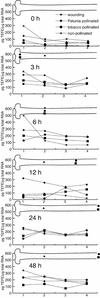Dynamic 1-aminocyclopropane-1-carboxylate-synthase and -oxidase transcript accumulation patterns during pollen tube growth in tobacco styles
- PMID: 12427986
- PMCID: PMC166640
- DOI: 10.1104/pp.007831
Dynamic 1-aminocyclopropane-1-carboxylate-synthase and -oxidase transcript accumulation patterns during pollen tube growth in tobacco styles
Abstract
In flowering plants, pollination of the stigma sets off a cascade of responses in the distal flower organs. Ethylene and its biosynthetic precursor 1-aminocyclopropane-1-carboxylate (ACC) play an important role in regulating these responses. Because exogenous application of ethylene or ACC does not invoke the full postpollination syndrome, the pollination signal probably consists of a more complex set of stimuli. We set out to study how and when the pollination signal moves through the style of tobacco (Nicotiana tabacum) by analyzing the expression patterns of pistil-expressed ACC-synthase and -oxidase genes. Results from this analysis showed that pollination induces high ACC-oxidase transcript levels in all cells of the transmitting tissue. ACC-synthase mRNA accumulated only in a subset of transmitting tract cells and to lower levels as compared with ACC-oxidase. More significantly, we found that although ACC-oxidase transcripts accumulate to uniform high levels, the ACC-synthase transcripts accumulate in a wave-like pattern in which the peak coincides with the front of the ingrowing pollen tube tips. This wave of ACC-synthase expression can also be induced by incongruous pollination and (partially) by wounding. This indicates that wounding-like features of pollen tube invasion might be part of the stimuli evoking the postpollination response and that these stimuli are interpreted differently by the regulatory mechanisms of the ACC-synthase and -oxidase genes.
Figures







Similar articles
-
Expression of the ACC synthase and ACC oxidase coding genes after self-pollination and incongruous pollination of tobacco pistils.Plant Mol Biol. 2002 Mar;48(4):351-9. doi: 10.1023/a:1014087914652. Plant Mol Biol. 2002. PMID: 11905962
-
Effect of pollination on accumulation of ACC synthase and ACC oxidase transcripts, ethylene production and flower petal abscission in geranium (Pelargonium x hortorum L.H. Bailey).Plant Mol Biol. 1997 Aug;34(6):855-65. doi: 10.1023/a:1005877809905. Plant Mol Biol. 1997. PMID: 9290638
-
Temporal and spatial regulation of 1-aminocyclopropane-1-carboxylate oxidase in the pollination-induced senescence of orchid flowers.Plant Physiol. 1993 Sep;103(1):31-9. doi: 10.1104/pp.103.1.31. Plant Physiol. 1993. PMID: 7516081 Free PMC article.
-
The regulation of ethylene biosynthesis: a complex multilevel control circuitry.New Phytol. 2021 Jan;229(2):770-782. doi: 10.1111/nph.16873. Epub 2020 Sep 12. New Phytol. 2021. PMID: 32790878 Free PMC article. Review.
-
Detoxification of cyanide by plants and hormone action.Ciba Found Symp. 1988;140:92-110. doi: 10.1002/9780470513712.ch7. Ciba Found Symp. 1988. PMID: 3073064 Review.
Cited by
-
Light differentially regulates the expression of two members of the auxin-induced 1-aminocyclopropane-1-carboxylate synthase gene family in mung bean (Vigna radiata L.) seedlings.Planta. 2004 Apr;218(6):976-88. doi: 10.1007/s00425-003-1183-4. Epub 2004 Jan 16. Planta. 2004. PMID: 14727113
-
The ethylene receptor regulates Typha angustifolia leaf aerenchyma morphogenesis and cell fate.Planta. 2019 Jul;250(1):381-390. doi: 10.1007/s00425-019-03177-4. Epub 2019 May 6. Planta. 2019. PMID: 31062160
-
Differential responses of the promoters from nearly identical paralogs of loblolly pine (Pinus taeda L.) ACC oxidase to biotic and abiotic stresses in transgenic Arabidopsis thaliana.Planta. 2010 Sep;232(4):873-86. doi: 10.1007/s00425-010-1224-8. Epub 2010 Jul 15. Planta. 2010. PMID: 20632186
-
Regulation of methylbenzoate emission after pollination in snapdragon and petunia flowers.Plant Cell. 2003 Dec;15(12):2992-3006. doi: 10.1105/tpc.016766. Epub 2003 Nov 20. Plant Cell. 2003. PMID: 14630969 Free PMC article.
-
Female gametophyte development, pollen‒pistil interactions and embryogenic patterns in chicory (Cichorium intybus): a self-incompatibility perspective.Plant Cell Rep. 2025 Jun 25;44(7):156. doi: 10.1007/s00299-025-03546-2. Plant Cell Rep. 2025. PMID: 40562964 Free PMC article.
References
-
- Clark DG, Richards C, Hilioti Z, Lind IS, Brown K. Effect of pollination on accumulation of ACC-synthase and ACC-oxidase transcripts, ethylene production and flower petal abscission in geranium (Pelargonium × hortorum L.H. Bailey) Plant Mol Biol. 1997;34:855–865. - PubMed
-
- Cox KH, Goldberg RB. Analysis of plant gene expression. In: Shaw CH, editor. Plant Molecular Biology: A Practical Approach. Oxford: IRL Press; 1988. pp. 1–34.
-
- De Martinis D, Cotti G, te Lintel Hekkert S, Harren FJM, Mariani C. Ethylene response to pollen-tube growth in the Nicotiana tabacum flower. Planta. 2002;214:806–812. - PubMed
Publication types
MeSH terms
Substances
LinkOut - more resources
Full Text Sources
Other Literature Sources

